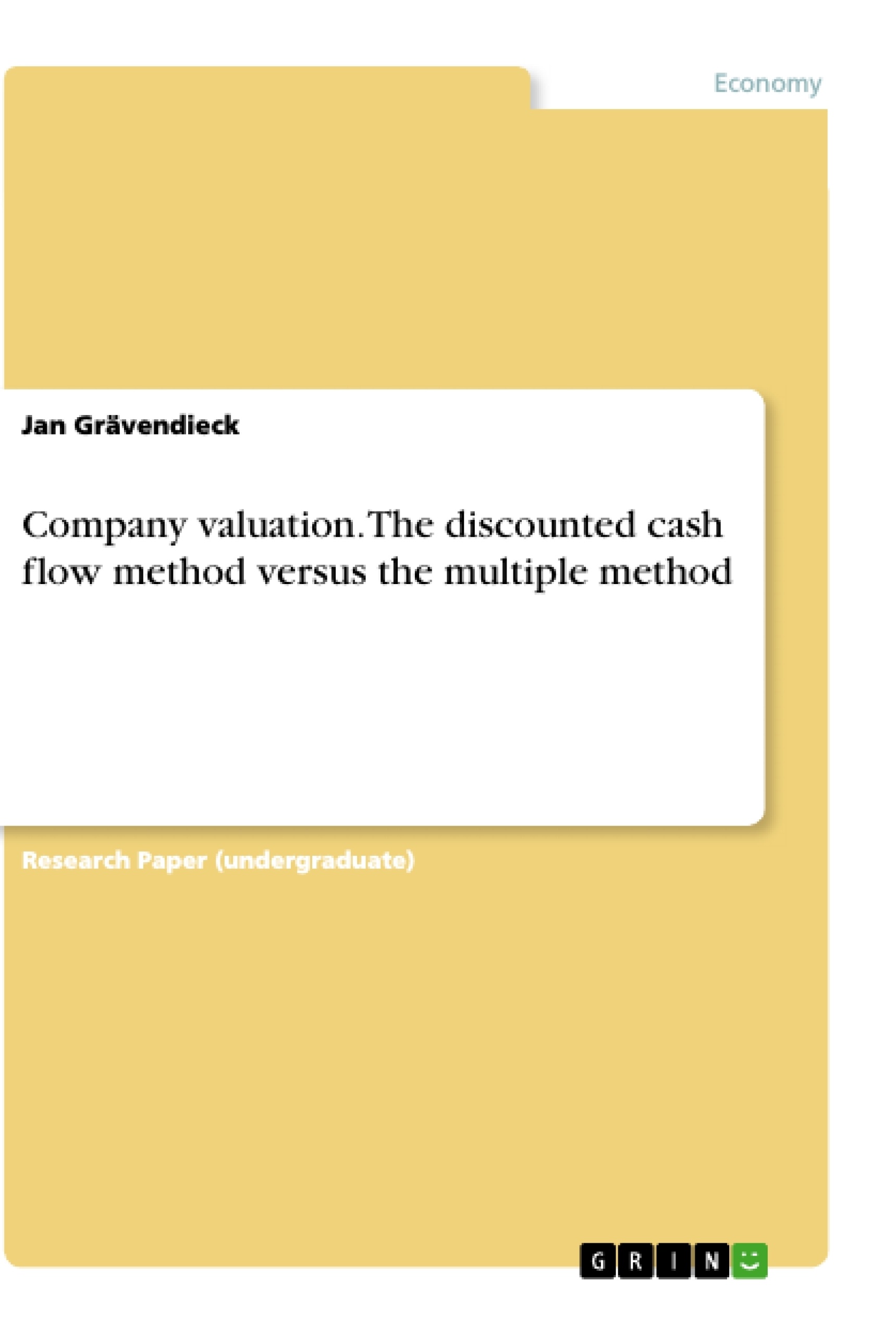This study gives an overview of the various aspects of the company valuation. It deals with the reasons for company valuations, how these can be classified and what the purpose of company valuations is. It also presents various methods of valuation of a company.
There can be significant differences between the value and price of a company. At the stock market, the equity value of a company is determined in a market economy manner: the number of shares is calculated on the basis of the share price, that is the price resulting from the supply and demand from the shareholders, or the price that a shareholder is prepared to pay for a share in the company.
The focus of this work lies on the discounted cash flow (DCF) method and the multiple method. The DCF method focuses on the WACC approach, the multiple method on the EBIT and sales multiple. The paper also applies the methods presented in the previous sections in practice. Three German DAX-listed automobile manufacturers, BMW, Daimler and Volkswagen, are evaluated using these two methods, and the results are then compared. The focus here lies on various scenarios in which the parameters of the valuation methods are adjusted. The three companies are compared with each other within the methods and between the different methods.
Inhaltsverzeichnis (Table of Contents)
- 1 Introduction
- 2 Valuation
- 2.1 Reasons for the valuation and its purpose
- 2.2 Methods for valuation
- 2.3 Total valuation method
- 2.3.1 German income approach
- 2.3.2 The discounted cash flow method
- 2.3.3 The comparison method
- 2.4 Individual valuation method
- 2.5 Other methods
- 3 The Discounted Cash Flow approach
- 3.1 Calculation of cash flow
- 3.2 Free cash flow approach
- 3.3 Total cash flow approach
- 3.4 Adjusted present value approach
- 3.5 Flow to equity approach
- 3.6 Pros and cons
- 4 The Multiple Method
- 4.1 Methods of Multiple Valuation
- 4.2 Process of Multiple Valuation
- 4.2.1 Analysis of the company
- 4.2.2 Multiples selection
- 4.2.3 Selection peer group
- 4.2.4 Valuation
- 4.2.5 EBIT Multiple
- 4.2.6 Sales Multiple
- 4.3 Pros and cons
- 5 Practical Valuation for Three Automotive Manufacturers
- 5.1 General Approach and Database
- 5.2 Market Growth for the Automotive Market
- 5.3 Discounted Cash Flow Valuation
- 5.3.1 Calculation of Free Cash Flow, WACC and Net Debt
- 5.3.2 DCF Valuation of the BMW Group AG
- 5.3.3 DCF Valuation of Daimler AG
- 5.3.4 DCF Valuation of Volkswagen AG
- 5.3.5 Overview of DCF Scenarios 1-3
- 5.4 Multiple Valuation with the EBIT and Sales Multiples
- 5.4.1 FINANCE Multiples
- 5.4.2 Multiple Valuation of the BMW Group AG
- 5.4.3 Multiple Valuation of Daimler AG
- 5.4.4 Multiple Valuation of Volkswagen AG
- 5.4.5 Overview of Multiple Scenarios
- 5.5 Summary
- 6 Conclusion
Zielsetzung und Themenschwerpunkte (Objectives and Key Themes)
This independent study analyzes two commonly used valuation methods: discounted cash flow (DCF) and multiples. The paper compares these approaches, examining their advantages and disadvantages, and provides a practical application by valuing three automotive manufacturers. The goal is to demonstrate the application of these methods in real-world scenarios and to highlight the strengths and weaknesses of each approach.
- Comparison of DCF and multiples valuation methods
- Analysis of advantages and disadvantages of each method
- Practical application of both methods to automotive manufacturers
- Evaluation of the accuracy and limitations of the valuation methods
- Examination of the role of market growth and financial assumptions in valuation
Zusammenfassung der Kapitel (Chapter Summaries)
Chapter 2 provides a comprehensive overview of valuation methods, including the total valuation method, the individual valuation method, and other less-used methods. The chapter explores various approaches for determining the value of a company, setting the stage for the deeper analysis of DCF and multiples in later chapters.
Chapter 3 delves into the DCF approach, outlining its calculation methods and variations, including free cash flow, total cash flow, adjusted present value, and flow to equity. The chapter also discusses the strengths and weaknesses of the DCF approach, highlighting its dependence on future cash flow projections and the impact of discount rate assumptions.
Chapter 4 focuses on the multiples method, exploring its underlying principles and practical application. The chapter discusses the process of selecting appropriate multiples, identifying comparable companies, and performing valuation calculations. It also examines the advantages and disadvantages of using multiples, emphasizing the importance of selecting relevant and reliable data.
Chapter 5 provides a practical application of both DCF and multiples methods to three automotive manufacturers: BMW Group AG, Daimler AG, and Volkswagen AG. The chapter presents detailed valuations based on each method, illustrating the impact of different assumptions and scenarios. The chapter concludes with an overview of the valuation results and a discussion of the potential implications for investors and other stakeholders.
Schlüsselwörter (Keywords)
This study focuses on key concepts in corporate finance, specifically examining valuation methods using discounted cash flow (DCF) and multiples analysis. The research also explores practical applications of these methods in the automotive industry, analyzing companies like BMW Group AG, Daimler AG, and Volkswagen AG. Important themes include market growth, financial assumptions, and the interplay between different valuation approaches. The study aims to provide insights into the strengths and limitations of various valuation methods, equipping readers with a better understanding of these tools and their applications in real-world settings.
- Quote paper
- Jan Grävendieck (Author), 2019, Company valuation. The discounted cash flow method versus the multiple method, Munich, GRIN Verlag, https://www.grin.com/document/494412




